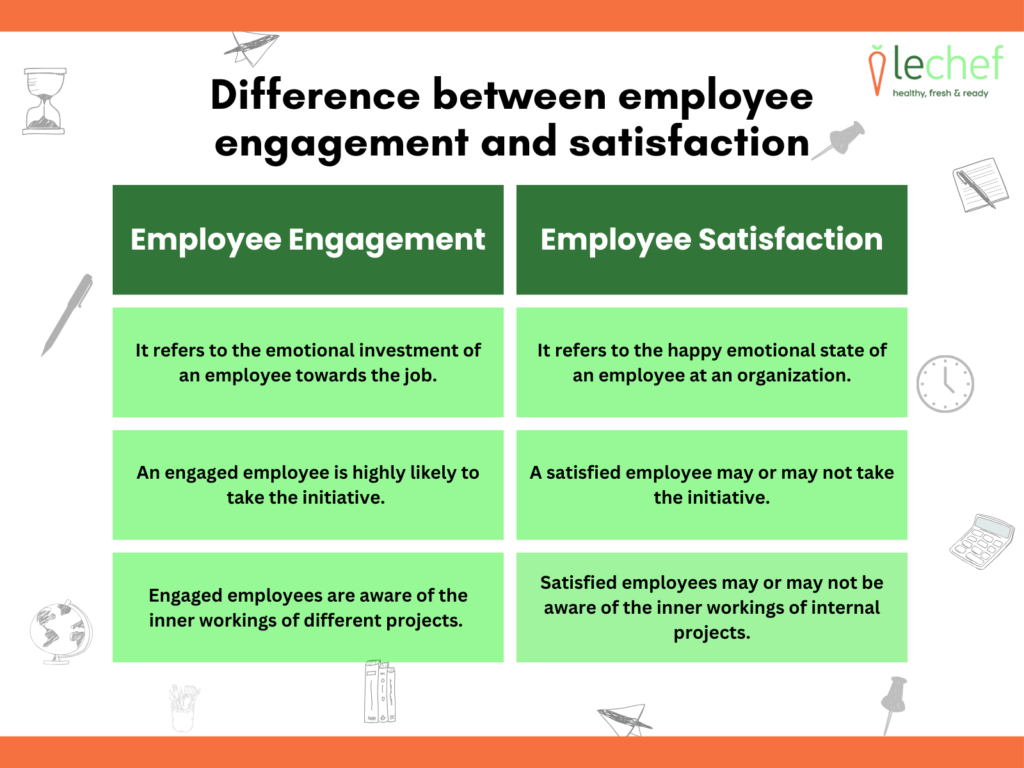
Employee engagement has a number of definitions from major players across the globe. As per Forbes, it means the emotional connection an employee has to an organization and its goals while Jim Whitehurst, the CEO of Red Hat, defines employee engagement as “the art of getting people to believe what you want them to believe.”



One crucial thing to note is that none of these differentiators mean that employee satisfaction should be set aside. In fact, these days, it is more difficult to retain an employee than to hire one, and that’s because of low employee satisfaction. Employee satisfaction is just as crucial as employee engagement.
Only a mere 15% of the employees are actually engaged in their jobs. While this factoid only represents the state of employment in the United States, there’s been a global change in the way people look at jobs. Unfortunately, employers these days haven’t realized that employees have been seeing through the tactics an organization throws their way when they really wish to enjoy their work. Overburdened, underpaid, and nothing along the way of a genuine good time. That’s what employees have been suffering from.
For obvious reasons, this leads to a steep decline in employee engagement, resulting in poor performance. To avoid such a scenario and to promote a healthy workspace culture, here’s what you need to do as an employer:

One of the most common mistakes that employers and team leaders do is gloss over the issues their team has. Doing so not only hurts the credibility and character of the employer but also demotivates the team from putting in the required effort for even the most menial tasks. If you’re an employer or a team leader, please understand that your organization constitutes your workforce above any product or service that you offer.
By simply taking some time off your schedule to talk to the employees, you will understand the underlying issues they might face. Issues pertaining to resource management, working conditions, and more might pop up. Now, you might not be able to rectify certain problems on the spot, but lending a hearing ear to your team will surely make them feel heard and understood. This builds trust and faith in the existing system that you’ve established. Hence, hearing from your team members is a crucial aspect of building employee engagement, as the more you hear about different problems, the more you connect with your workforce.
One of the best ways to improve employee engagement at your organization is to simply encourage your workforce during tough times. Sometimes, your team may be the second best or miss the best-selling product award by a handful of downloads. Such moments breed tension, sorrow, and, if handled negatively, fear. The last thing a dedicated team member who has worked for you wants to hear is you doubling down on them for a mistake they might not be a part of.
Wins and losses are a part of life. The same is the deal with businesses across the globe. No single business can run a perfect year, let alone a decade. Such times demand a better approach towards employee management. What you need to do is stand with your team. If they perform well and you overachieve your performance metrics, dedicate the victory to your team. If there’s been a mishandling of resources and you’ve incurred a defeat or a loss, don’t blame your team for it. Instead, highlight the issues and the solutions to fix them while motivating your team to learn from the experience and do better next time.
As strange as it might sound, nutrition has a lot to do with employee engagement and satisfaction. Not every employee has the liberty of bringing a healthy and tasty homemade lunch every day. Some may wait for the lunch break to begin so that they can walk out of the office campus and get something to eat. Now, this isn’t a bad practice by any means, after all, there’s a dedicated lunch break that every employee has to follow.
However, there are a few underlying issues that most employers and team leads often gloss over. If you can provide a healthy and delicious meal to your workforce at the workplace itself, your employees will not only love it but save the time spent on looking for alternative methods to feed themselves. Workspace dining has its set of challenges that may plague your team nurturing efforts, here’s how:
The best way to navigate and overcome these challenges is to install a system that provides your workforce with the healthiest and tastiest meals at the office premises in an instant.
With the lechef smart fridge, you can do just that. The lechef smart fridge houses a number of healthy meal options that an employee can take by scanning the QR code on the fridge. Each of these smart fridges can cater to 50 employees with healthy, tasty, and affordable meals.
You can also save up to 11 hours per employee monthly on breaks. As strange as it might sound, employee engagement will see a boost if you know how and what to feed your workforce when they’re hungry.



